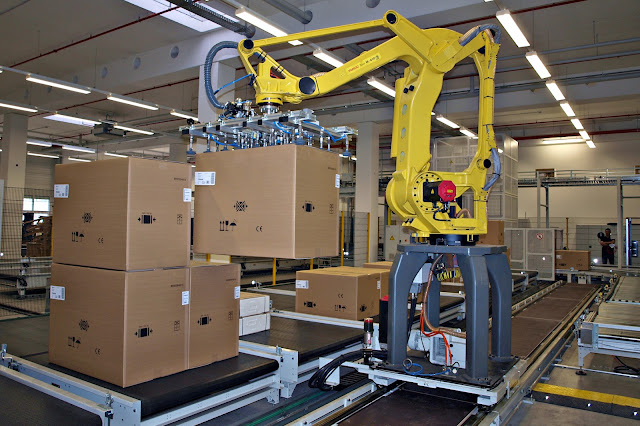Overview Of Material Handling Robotics: Game Changer in Manufacturing Logistics
 |
With advances in robotics technology, material handling robots are revolutionizing manufacturing logistics operations around the world. These robots are specifically designed to assist humans in transporting, storing, packaging and preparing raw materials, work-in-process inventory and finished goods in factories and warehouses.
Types of Material Handling Robots
There are several common types of Material
Handling Robotics used in industry today:
Autonomous Mobile Robots (AMRs)
AMRs are self-driving robots that can navigate factory floors and warehouse
aisles without needing guidance wires or magnets embedded in the floor. Using
algorithms, sensors and vision systems, AMRs can locate themselves and detect
people or obstacles to safely move materials around. Popular models include
LocusBots, Fetch and Brain Corp robots.
Articulated Robotic Arms
Articulated robotic arms resemble the human arm, with joints that allow
flexibility of movement. In materials handling, these robots are commonly used
for tasks like palletizing, depalletizing, picking and packaging. Examples
include robots from KUKA, ABB, Universal Robots and Rethink Robotics.
Cartesian Robots
Cartesian robots use a gantry system of sliding components to move materials
in a precise x, y, z coordinate system. They are well-suited for applications
involving high payloads or bulky loads that need to be lifted, lowered or
transported point-to-point. Yaskawa, Kawasaki and FANUC make popular Cartesian
robot models.
Collaborative Robots (Cobots)
Cobots are robotic arms designed to safely work alongside human workers. Using sensors and controls, cobots can detect a person and stop or adjust its motion as needed to avoid collisions. Popular cobots include offerings from Universal Robots, ABB, Techman and Franka Emika.
AGVs and ATVs
Automated guided vehicles (AGVs) and automated transfer vehicles (ATVs) are
self-driving platforms that operate within confined paths or routes to move
payloads from one station to another. Models vary in loading capacity and
include powered pallet trucks, unit load vehicles and tuggers. Common brands
are JBT, Seegrid, Scott and Dematic.
Advantages of Material Handling
Automation
Implementing material handling robotics delivers several competitive advantages for manufacturers and logistics operations:
Increased Productivity and Throughput
Robots work non-stop in three shifts a day to move materials faster than
human workers can while maintaining consistent repetition of tasks. This allows
for higher productivity and throughput.
Improved Accuracy and Quality
Robots eliminate errors from fatigue or distractions and work with precise
consistency. They also handle payloads and position items with repeatable
accuracy to reduce defects and improve quality.
Enhanced Safety
Robotic technologies eliminate risks to humans from physically demanding,
monotonous or hazardous material handling tasks like lifting heavy loads. This
significantly improves overall workplace safety.
Reduced Labor Costs
Robots require no overtime pay, vacations or benefits. While upfront
investment is needed, robots deliver ongoing cost savings versus human labor
over the long-run through 24/7 operation.
Optimized Warehouse and Factory Space
Robots efficiently utilize vertical space with lifting capabilities. They
also deliver optimized workflows, shorter batch runs and less wasted motion
versus manual material movement methods. This maximizes available floor space.
Applications of Material Handling
Robotics
Material handling robotics are deployed across diverse applications in
manufacturing industries:
Automotive Plants
Robots move parts bins, sub-assemblies and finished vehicles between
workstations on the assembly line with precision and speed. They also handle
duties in body shops, paint shops and parts warehouses.
Electronics Factories
Cobots and AGVs transport semiconductor wafers and circuit boards neatly
between production processes. Robotic arms precisely place electronic
components on boards during assembly.
Food and Beverage Facilities
Robots help increase quality by hygienically conveying food products, cases
and containers. They efficiently handle fulfillment, order picking, palletizing
and depalletizing of goods in cold storage environments.
Warehouses and Distribution Centers
Autonomous mobile robots transport inventory between racks, delivery
locations, shipping areas and more. Robotic arms and lift trucks boost
productivity in tasks like putaway, replenishment, order picking and item
consolidation.
Material handling robotics offer unprecedented value for functions across
manufacturing supply chains. As enabling technologies advance, the potential
for robotics to optimize logistics operations continues growing exponentially
each year. Increased intelligence, sensing, precision and safety are making
these systems more versatile than ever before for diverse applications handling
everything from tiny electronics to bulk commodities. Robotics will undoubtedly
play a transformational role in shaping the future of manufacturing and supply
chain automation.
Gets More Insights on: Material Handling Robotics



Comments
Post a Comment